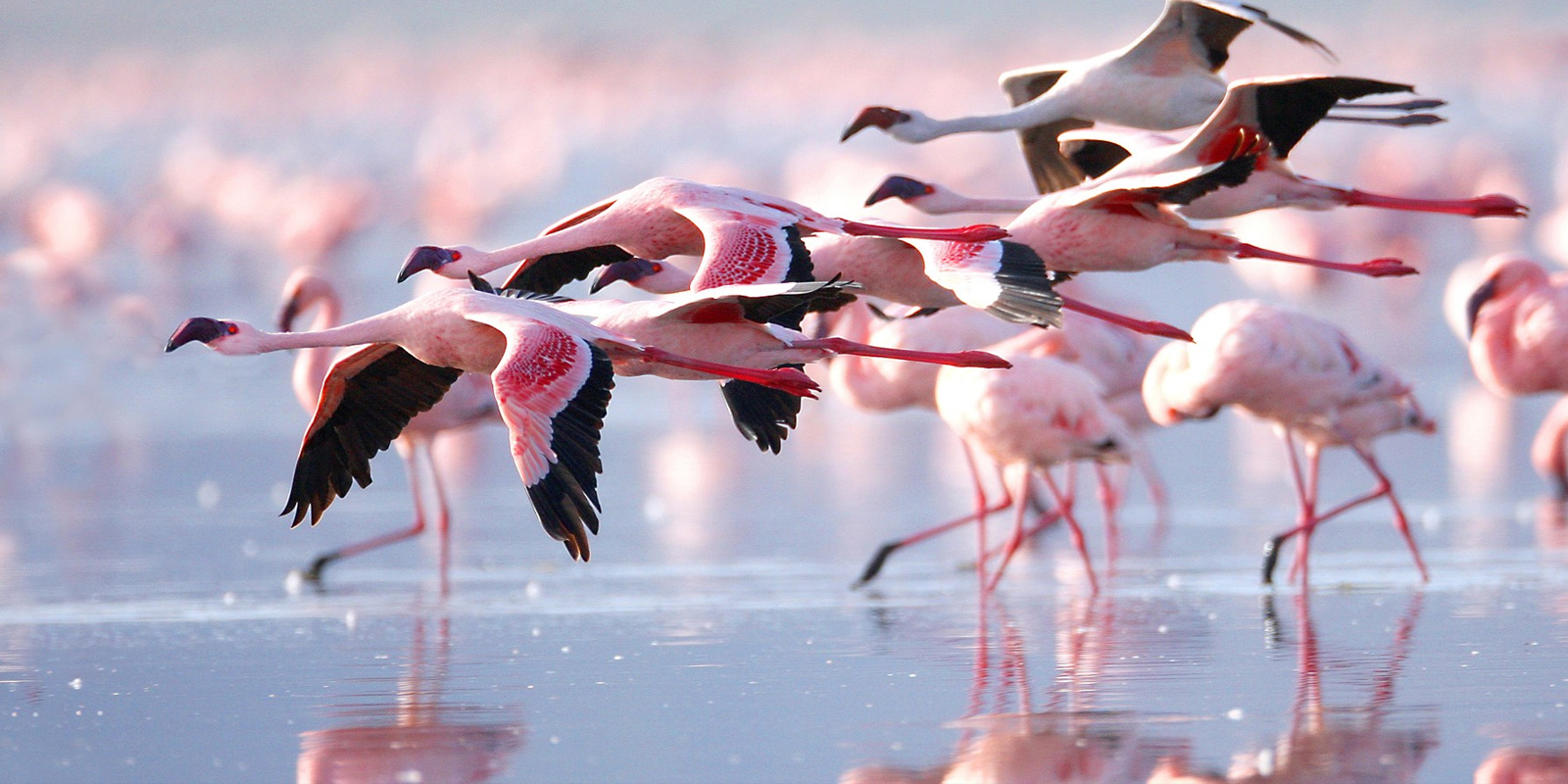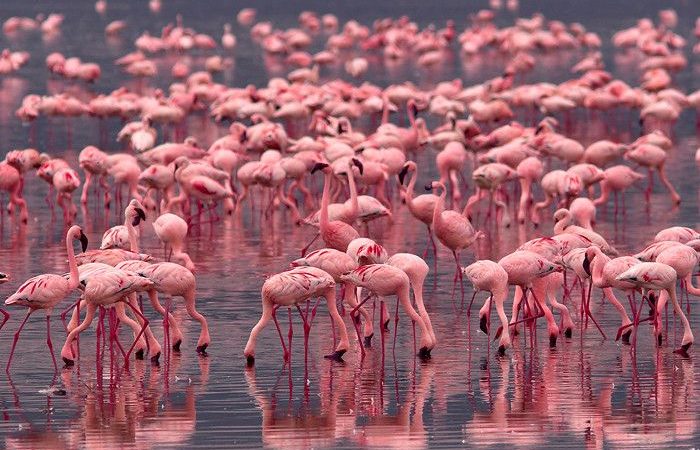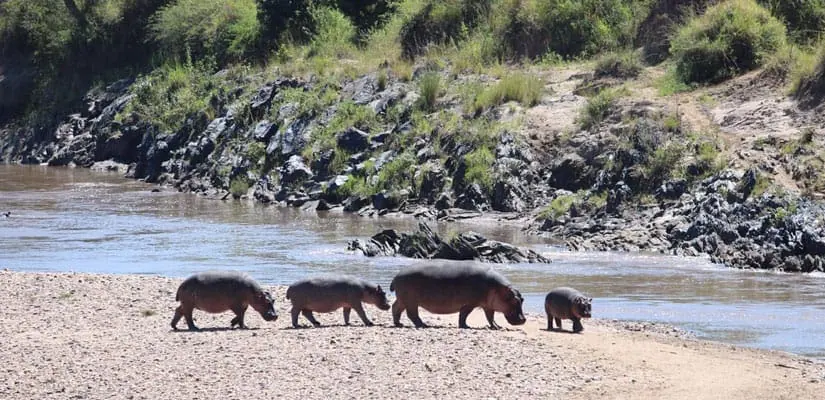- GET IN TOUCH WITH US:
- +256 753518160
- +256 777842166
- info@experiyatourcompany.com

What are Kenya’s best birding spots?
November 19, 2025
Can I camp inside Kenyan national parks?
November 19, 2025What’s Special About Lake Nakuru’s Flamingos?
Few wildlife spectacles in Africa are as breathtaking and iconic as the vast, shimmering pink flocks of flamingos that have long adorned the shores of Lake Nakuru. The sight of millions of these elegant birds gathering at the water’s edge is a scene that appears almost surreal—like a pastel painting brought to life. Travelers from around the world journey to Lake Nakuru to witness this natural wonder, captivated by the sweeping beauty, the rhythmic movements, and the ecological significance of one of Kenya’s most treasured wildlife phenomena. But what exactly makes Lake Nakuru’s flamingos so special? Why has this lake become synonymous with these birds, and what keeps them returning year after year? This detailed exploration uncovers the magic, the science, and the uniqueness behind Lake Nakuru’s flamingos, offering a comprehensive understanding of what makes this East African site one of the most enchanting birding destinations on earth.
The Unique Environment of Lake Nakuru
Lake Nakuru is an alkaline lake situated in Kenya’s Great Rift Valley, a region shaped by millions of years of geological activity. This alkaline nature forms the foundation of what makes the lake so attractive to flamingos. The waters of Lake Nakuru are rich in cyanobacteria, commonly known as blue-green algae, which thrive in the high-mineral environment. These algae form the primary food source for flamingos and are directly responsible for the vibrant coloration of their feathers.
As sunlight reflects off the shallow waters, the lake reveals different hues depending on the time of day and the season. When flamingos gather in large numbers, their bodies create a dense pink carpet along the shoreline. This combination of reflective waters, warm African skies, and thousands of flamingos resting and feeding creates a vibrant landscape that feels like a living piece of art. The lake’s shallow depth also makes it ideal for feeding, allowing flamingos to wade effortlessly through the water while filtering algae with their curved, specialized beaks.
The Phenomenon of Flamingo Coloring
One of the most captivating aspects of flamingos is their striking pink coloration, and Lake Nakuru’s flamingos are among the brightest in the world. Their color comes from carotenoid pigments found in the algae they consume. Specifically, the cyanobacteria in Lake Nakuru contain high levels of beta-carotene, which flamingos metabolize and store in their feathers, skin, and beaks.
Interestingly, flamingos are not born pink. Chicks start with greyish-white plumage and gradually develop their vibrant color as they feed. The richer and more abundant the algae, the deeper the pink hue becomes. In seasons when the algae bloom abundantly, the flamingos appear even more vibrant, creating a dramatic visual effect against the backdrop of the Rift Valley escarpments.
Lake Nakuru’s ecosystem supports these algae blooms consistently, making the lake one of the world’s most dependable feeding grounds for flamingos. This reliable food source plays a major role in sustaining the large populations that congregate here.
 Two Species: Lesser and Greater Flamingos
Two Species: Lesser and Greater Flamingos
Lake Nakuru is home to two distinct species of flamingos—the Lesser Flamingo and the Greater Flamingo. The Lesser Flamingos are the more numerous of the two and typically form the massive pink flocks for which the lake is famous. They are smaller, with deeper pink coloration and a dark, downward-bent bill specially adapted for feeding on microscopic algae.
Greater Flamingos, on the other hand, are larger and paler, with a more pronounced downward-curving bill suitable for sifting crustaceans and larger organisms from the water. While they do not gather in the same monumental numbers as Lesser Flamingos, they add a beautiful contrast to the lake’s birdlife and play an important ecological role.
The coexistence of these two species adds to the richness of Lake Nakuru’s avian diversity. Each species feeds differently, reducing food competition and allowing both populations to thrive.
The Feeding Behavior of Flamingos
Flamingos are filter feeders, relying on a unique method of feeding that involves shaking their heads side-to-side underwater while their beaks are partially submerged. Their beaks act like sieves, trapping algae and other microscopic organisms while expelling water and mud. This efficient feeding mechanism allows them to consume large quantities of algae each day.
Lake Nakuru’s shallow edges are perfect for this feeding technique. The water’s low depth ensures that flamingos can reach the algae effortlessly, while the lake’s mineral-rich composition fuels ongoing algae reproduction. This creates a sustainable cycle: the more algae the lake produces, the more flamingos it attracts, and the more vibrant the pink colonies become.
The Migration Cycles of Nakuru’s Flamingos
While Lake Nakuru is the most famous flamingo hotspot in Kenya, the flamingos themselves do move between neighboring lakes in the Rift Valley such as Lake Bogoria, Lake Elmenteita, and Lake Magadi. These movements are driven primarily by changes in water levels, food availability, and the lake’s mineral balance.
During periods when Nakuru’s water levels rise too high or algae production dips, flamingos may shift to Lake Bogoria, whose hot springs and geothermal activity support continuous algae growth. Conversely, when conditions stabilize at Nakuru, the birds return in enormous numbers, sometimes forming flocks of up to two million individuals.
This migratory pattern means that flamingo numbers at Lake Nakuru fluctuate, but regardless of the season, the lake rarely loses its status as a top flamingo habitat. Even smaller gatherings at Nakuru remain spectacular—flamingos anywhere along the Rift Valley lakes create visual displays that leave travelers in awe.
The Ecological Importance of Flamingos
Flamingos are more than just beautiful birds; they are vital indicators of ecosystem health. Their presence reflects the balance of algae growth, water mineral levels, and general environmental conditions. For scientists and conservationists, monitoring flamingo populations at Lake Nakuru helps track ecological changes and possible threats such as pollution, climate shifts, and human activity around the lake.
Beyond their ecological symbolism, flamingos also contribute significantly to the local economy. Birdwatchers, photographers, and wildlife lovers from across the globe visit Lake Nakuru to see these birds, supporting tourism, conservation funding, and community livelihoods.
Flamingos and Lake Nakuru National Park
Lake Nakuru’s flamingos are protected within Lake Nakuru National Park, one of Kenya’s most cherished conservation areas. The park is home to an impressive variety of wildlife, including rhinos, lions, giraffes, leopards, waterbucks, and more than 450 bird species. Flamingos, however, remain its most iconic residents.
The park’s viewpoints—such as Baboon Cliff and Lion Hill—offer sweeping panoramas of the lake, from which visitors can see the pink band of flamingos stretching along the shoreline. These views are especially enchanting during sunrise or sunset when the soft light illuminates the birds’ plumage. Photographers often refer to Lake Nakuru as one of the best African destinations for capturing flamingos in flight, feeding, or congregating in elegant patterns.
Travelers visiting the park not only witness the beauty of the flamingos but also gain insights into the balance of species, the fragility of lake ecosystems, and the importance of conservation efforts in protecting endangered habitats.
The Changing Patterns of Flamingo Populations
Lake Nakuru’s flamingo populations have fluctuated over the years due to environmental factors such as increased rainfall, rising water levels, and changes in algae availability. At times, rising lake waters submerge the algae beds, pushing the flamingos to nearby lakes. In other moments, the lake rebounds, the algae flourish, and millions of birds return in breathtaking waves.
Despite these fluctuations, Lake Nakuru remains central to the flamingo story. The lake’s geography, its protected status, and its place within the Rift Valley ecosystem mean it continues to attract flamingos year after year. For visitors, witnessing even a fraction of these iconic flocks is a magical experience that stays with them long after they leave.
What Makes Lake Nakuru’s Flamingos Truly Special?
What makes these flamingos special is not just their beauty but their connection to the land, the water, and the cultural identity of Kenya’s wild spaces. They embody the harmony of the lake’s natural processes—the minerals in the water, the sunlight on the algae, the wind brushing across the hills, and the unbroken cycles of nature. Their dance across the lake’s surface, their synchronized movements in flight, and their collective presence create a phenomenon that feels both ancient and ephemeral.
Lake Nakuru’s flamingos remind us of the delicate balance of ecosystems and the wonder that arises when nature thrives undisturbed. For travelers, they deliver a rare and moving encounter that blends science, art, and emotion in a single moment.
Book Your Flamingo Safari with Experiya Tour Company
If you want to witness the beauty of Lake Nakuru’s flamingos, consider booking your journey with Experiya Tour Company. Their experts craft personalized safari experiences that take you to the heart of Lake Nakuru National Park, ensuring you enjoy breathtaking views, expert guiding, comfortable travel arrangements, and unforgettable wildlife moments. Experiya Tour Company blends local expertise with passion for nature, making your flamingo safari deeply rewarding from start to finish.




